|
Easter Island
The Island Occupied by Czechs
While waiting at the gate to be let on to the plane, I heard the Czech language being spoken. Three young compatriots (two ladies + one man) were giving vent to their problems about their luggage. They had been stuck in Madrid due to overbooked flights, then departed the next day via another route. And, as is the rule, their luggage went on the original flight. Usually this is settled in one day before the passenger and luggage are reunited, but in their case this somehow did not happen. Their baggage arrived five days later, at the time of their departure from the Island. Easter Island is small, so we met almost daily, sometimes in the road, sometimes at a folk performance. So it was unavoidable. I had to at least have a joint photo taken with David.
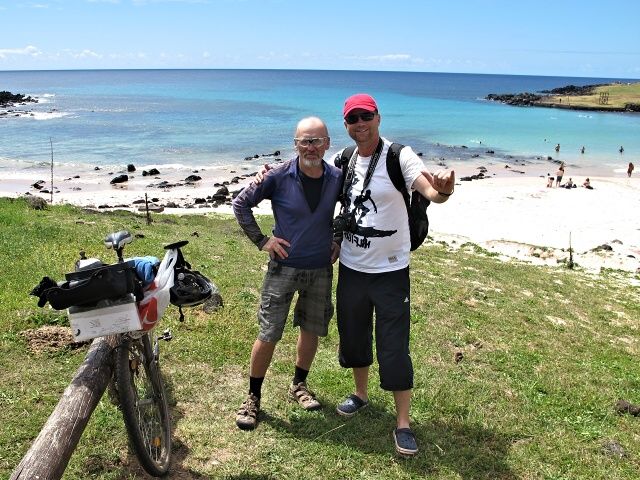
[Easter Island] Anakena – I met the Czech people from the plane – the island is so small
The flight was pleasant. Accompanied by the good wine served by flight attendants, the more than five hours passed quickly. The Oldies available on the in-flight audio system also contributed to this. Apparently, due to copyright expiration, there was an incredible supply of this music. I listened to two Zimmerman (Bob Dylan) recordings, before reminiscing on my student years and departed friends with some Creedence Clearwater Revival hits. I was not concerned about accommodation on the Island, as a camp was marked on the map less than 2 km from the Airport.
The birds of prey were already lurking at the Airport. They correctly assessed that I was heading for the camp. Originally I had wanted to assemble the bike and cycle there, but they told me not to mess around and loaded everything on to their pick-up. An hour later, I had a tent erected on the coast which faced the first drizzle on the South American continent. By the way, the camp was on Avenida Pont and the owner was Marta Pont. So I asked her about it – her father was French and when he arrived on the island, he had bought a very large piece of land, so Marta and her husband Robert were really home and dry. The campsite was clean, the tents were pitched on sparse grass about 50 meters from the sea pounding the rocks with waves several meters high. There was a huge kitchen, each visitor had a big locker, which accommodated all my luggage. In addition, there was free WiFi.
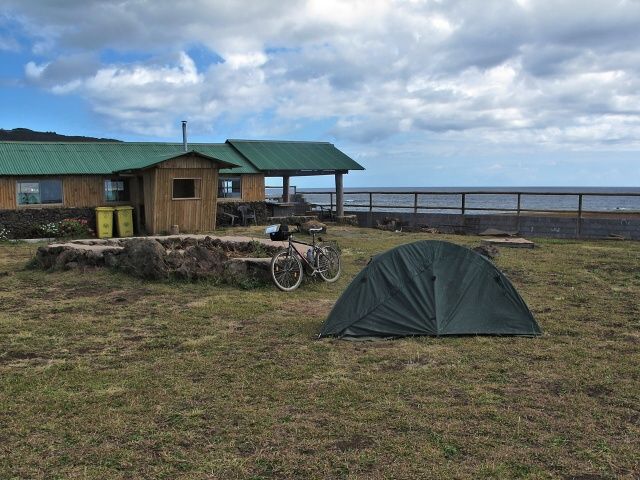
[Easter Island] Camping was right at the seaside; there wasn´t any smaller tent than mine
Change of Departure Date
In the morning, I hunted for a good cycling map. Of course I found one at the bike rental store, a black and white map, rather schematic, but showing all the roads, paths and cycling routes, including the mileage and all the sights. I realized that five days was too long for me to see everything, so I stopped in the LAN office and changed my departure date from the Tuesday to the Sunday (free of charge).
East Coast
Then I began to cycle along the East coast. It started quietly, simply an island with a rugged coastline, huge waves and uninteresting vegetation, mostly grass and low bushes. Only the middle of the island is forest. The unusually shaped hills were impressive, not denying their volcanic origin. Otherwise, there was only a moderate undulation, the highest hill being about 500 meters. Without bags, I did not cycle but rather flew. I felt a strong excess of energy, so I humiliated all those sporadic cyclists on their hired mountain bikes. Then the first erected moai appeared in the open countryside, a bay with numerous tumbled statues and scattered “hats”. I stopped my cycling fun and started to rush from one monument to another, thrilled with everything I saw. The first peak was the notorious Ahu Tongariki with 15 moai erected on the large ahu (pedestal) on the bay shore. This is a collection of original sculptures that were knocked down during the tribal wars, but quite recently re-erected.

[Easter Island] Ahu Tongariky – the largest set of re-erected statues
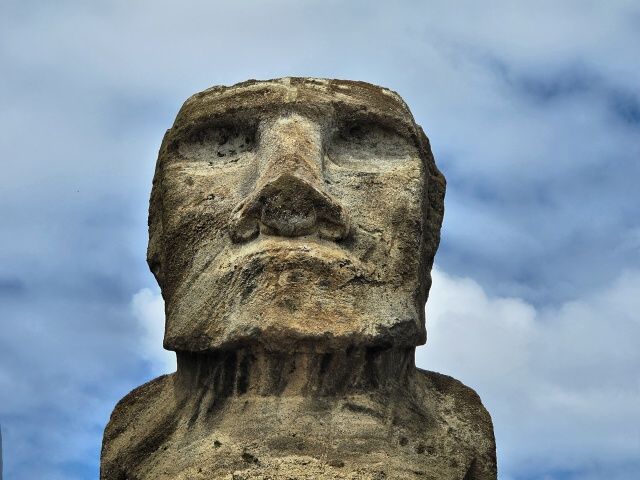
[Easter Island] Ahu Tongariky – the model was a handsome man, wasn't he?
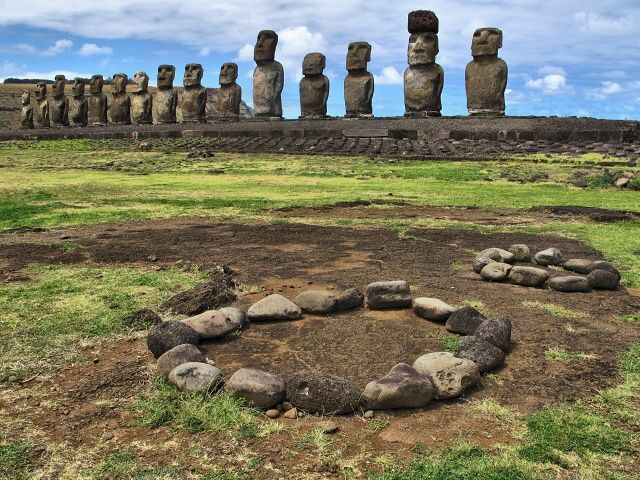
[Easter Island] Ahu Tongariky – the largest set of statues
Other highlights followed – petroglyphs (rock engravings) representing the local fauna and flora, the famous Navel of the World, which is dominated by a strongly magnetic rock which seemed to me unnaturally warm compared to the surrounding stones. There is a tiny beach in Ovahe where swimming is prohibited due to falling rocks and treacherous currents. A slightly larger beach in Anakena, which, thanks to palms and snow-white sand probably most resembles Polynesia, is surrounded by two archaeological sites and impressive moai, Ahu Nau Nau, each with a pukao (red topknot) and eyes made of coral. (On the last day I took a swimsuit and had a great swim in the not too warm, but beautifully clear water). Thus ended the first day, the paved road leading through the center of the island first led uphill for about 4 km and then I had a beautiful downhill 15-km ride to Hanga Roa.

[Easter Island] Papa Vaka – a set of prehistoric stone engravings
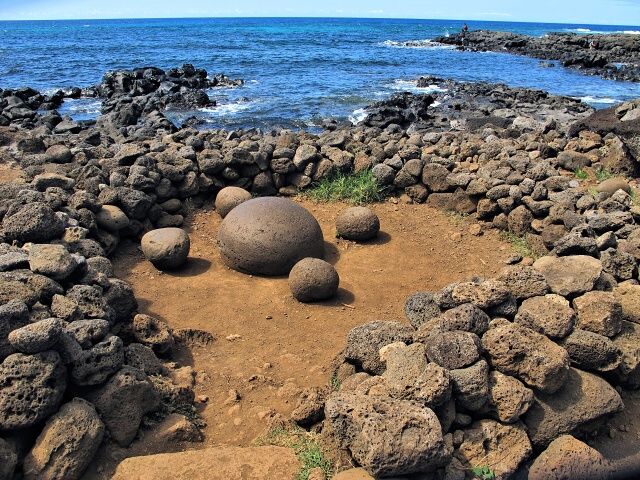
[Easter Island] Te Pito Kura – the navel of the Universe
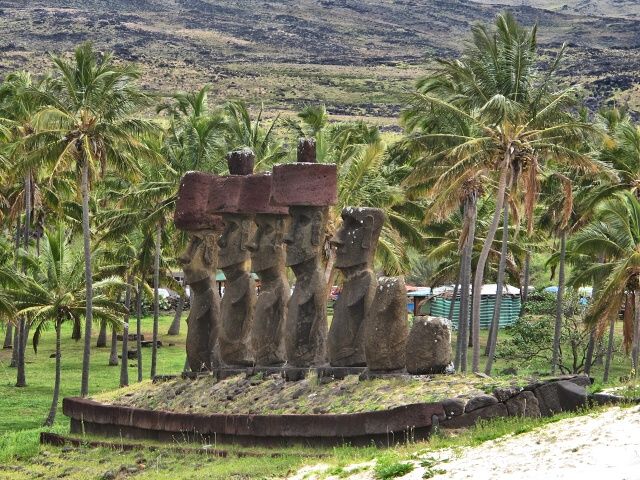
[Easter Island] Anakena - Ahu Nau Nau – a unique group with “hats”
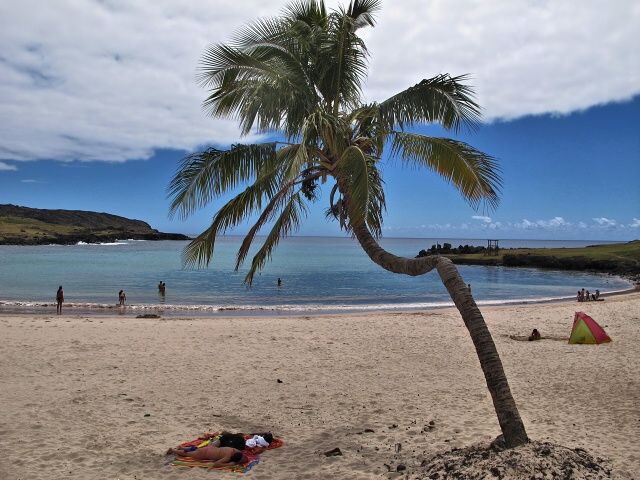
[Easter Island] Anakena – finally a Polynesian beach: bathing was pleasant, although not very warm
West Coast
The next day, I headed West, where the route is much shorter, because part of the coast has no road. Two moai are right at the port in Hanga Roa. The road continues around the local picturesque cemetery and on to the Tahai complex with 3 large ahu and many smaller buildings and ritual stone formations. Then follows a series of caves, such as the coastal Ana Kakenga and large inland Ana Te Pahu (banana cave), where banana trees grow in the open section, while the closed – underground – section serves as a water reservoir. The only inland plateau with moai is Ahu Akivi - it is said that it is a memorial to the seven young explorers who first occupied the island and founded its civilization.
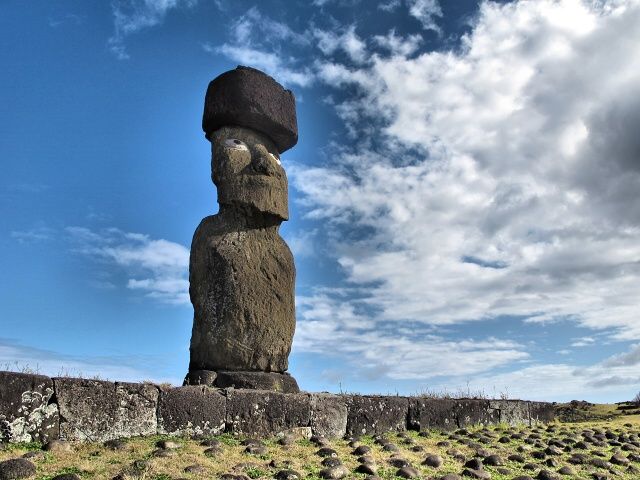
[Easter Island] Ahu Ko Te Riku – one of the few moai with eyes
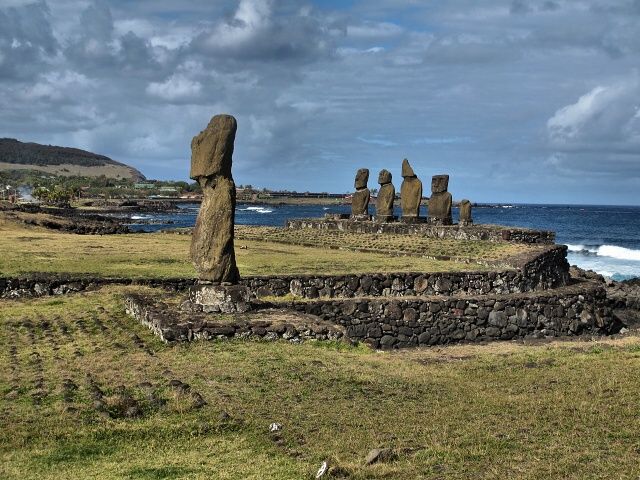
[Easter Island] In the front Ahu Tahai, a group on Ahu Vai Uri in the background

[Easter Island] Hanga Kio'e
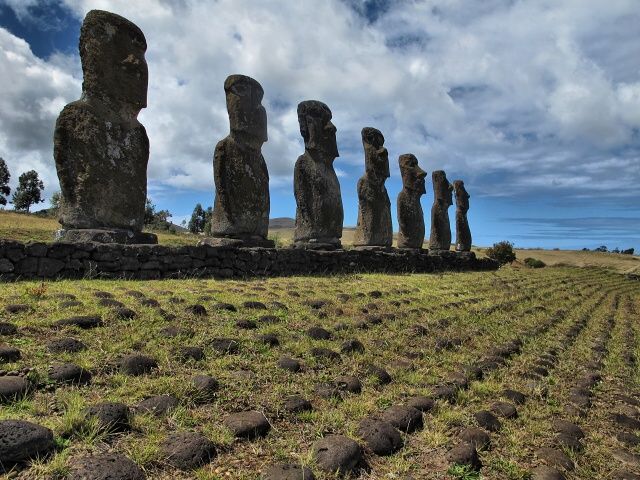
[Easter Island] Ahu Akivi – a memorial to seven young explorers who, according to legend, discovered the island
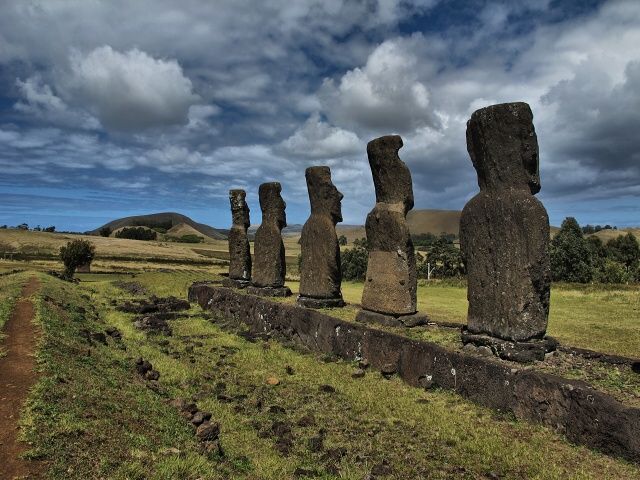
[Easter Island] Ahu Akivi – nobody takes a photo of moai from behind, except me
Another wonderful site is Puna Pau – local millinery – that is, a quarry in which pukao were manufactured. There were red rocks, the remnants of abandoned already completed pukao, some of a respectable size. And in addition, a beautiful view of the surroundings.
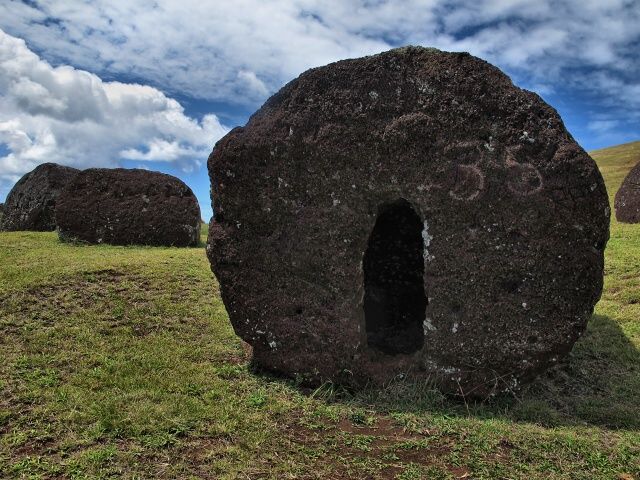
[Easter Island] Puna Pau – the quarry where the “hats” for moai were made – the remnants of unused products from the time when the inhabitants grew tired of their manufacture

[Easter Island] Puna Pau – it has never been put on the head of any moai
Orongo
I cycled down to the Airport. In the “supermercado” (a pretentious name for such a small store), I bought the local sweet cake to give me more energy for the next uphill ride. The owner recognized me from the previous day and asked where I was heading. Then the joker tossed a package of chewing gum at me, free of charge, reputedly to help me to survive the climb. The people here were really cool. It is indeed a very small island. It was only my second day here, but I already knew several locals and we had to shake hands at every meeting. And there were surprisingly few tourists there: a Swiss couple who took photos of me at Tongariki and some Dutch female cyclists whom I directed to the 300-meter distant Ana Te Paku, which they had not known about at all. There were also two American chicks on hired bikes whom I overtook in rough terrain at a speed of about 30 kph, while their speed was 5 kph. They obviously got a shock, as they confided to me that the evening in the town. Two Japanese Samurai, also on bikes, whom I overtook a couple of times and who, due to total exhaustion and the demoralization which I reputedly evoked in them, finished the rest of the journey to Hanga Roa by hitchhiking. We met again in the camp where we all were staying, not having known this before.
Here it Comes
So far so good, but the frenetic enthusiasm had not yet arrived. It came on the top of the climb to Orongo, where there is the Rano Kau crater of respectable size, with a diameter of 1,600 meters and a depth of 200 meters. At the bottom, there are swamps and lush vegetation. I was especially fascinated by the bitten-out edge on the southern side, where lava apparently had run off and poured into the sea. It would be best to take photos from the air, or with a very wide-angle lens. My photos are not so impressive, but the sight and sensation were indescribable. Added to this, there was also Orongo, a reconstructed ritual village that was used for only a few days a year, especially during the Bird Ceremony. The young men who swam to the island of Motu Nui (a much bigger rock in the sea) and brought the first bird’s egg back to the Island, enjoyed a great reputation the following year and commanded considerable authority. Houses were built of stones, double stone walls filled with soil. The ground plan was oval and boat-shaped. The houses cling to the outer rim of the crater above the sea. This is such an unreal place that I expected a hobbit to creep out of a house at any moment.
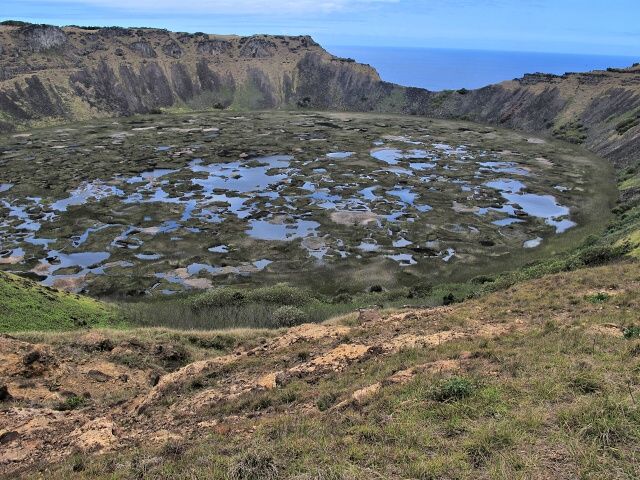
[Easter Island] Rano Kau crater has a 1600-meter diameter and 200-meter depth

[Easter Island] A view of the island from the rise on the Rano Kau crater
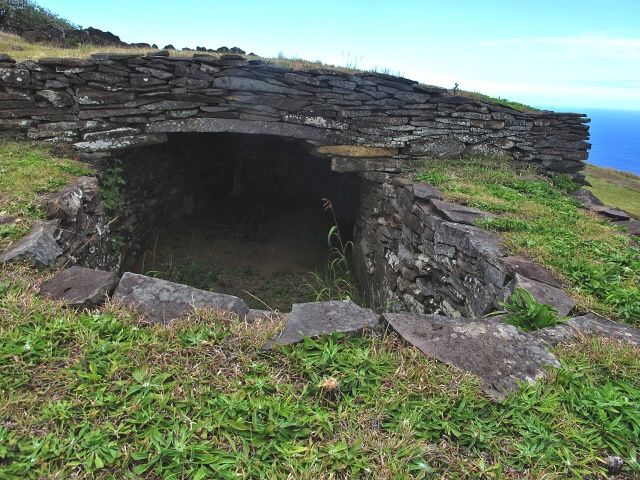
[Easter Island] Ritual Orongo village – house cross-section
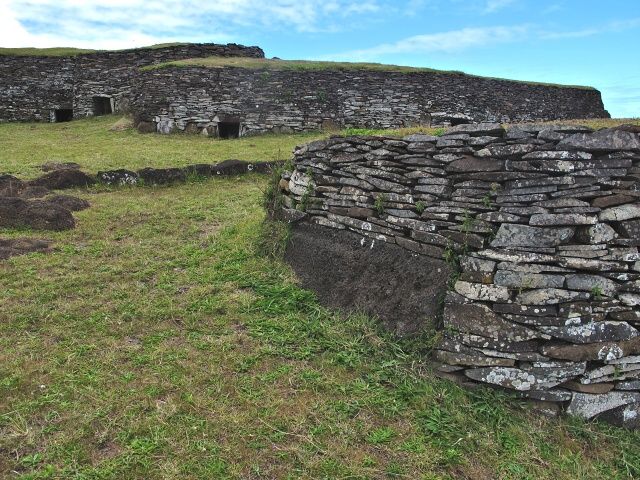
[Easter Island] Ritual Orongo village – I was waiting for the first hobbit to appear
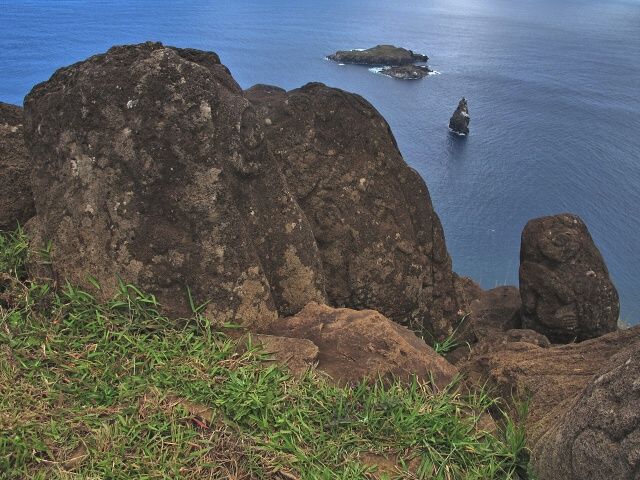
[Easter Island] Ritual Orongo village – stone engravings and 3 motu (islands) – on the largest, Motu Nuibyl, an important annual ritual takes place - the search for the first egg
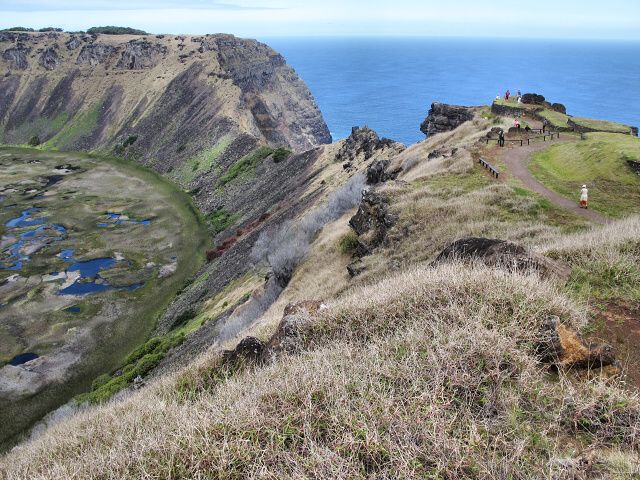
[Easter Island] Ritual Orongo village—the edge of the crater borders the Orongo village
In the evening, I went to take photos of the sunset at the moai in Tahai which is adjacent to Hanga Roa, about 3 km from the camp. I was captivated by the local Christian cemetery, where the lamps illuminating the moai, huddling in the gloom in the distant background, create an eerie atmosphere.

[Easter Island] The cemetery at Hanga Roa
On the last day, I revisited my favorite spots to take them in properly. I spent a lot of time in the moai factory, in the quarries at Mount Rano Raraku. This former volcano, naturally, had one side of the crater flooded with water, in which a local ranger was swimming. Wild horses were grazing on the luxuriant grass. They were very timid and, when I approached, the whole herd trotted away. On the other side of the crater was the quarry where visitors could view a number of unfinished moai. Some of the pieces were perhaps 8 meters long, carved horizontally into the landscape. Many statues are scattered on the slope, most had already been completed and were apparently awaiting transportation. From the quarry, one can see the bay where statues arise in Ahu Tongariki like a rake and, above them, towers the mountain on the least accessible peninsula, Poike.
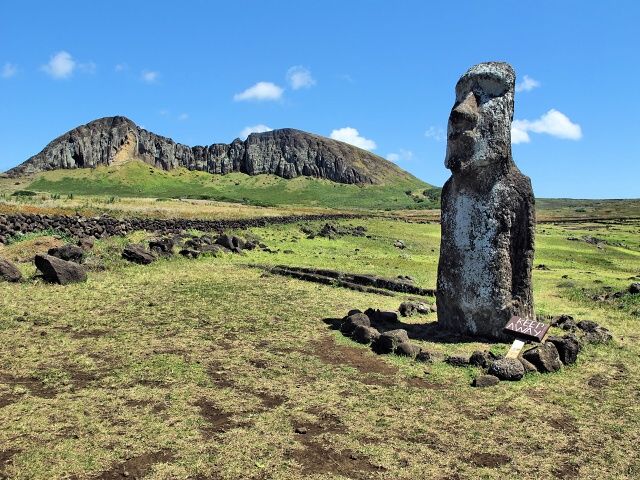
[Easter Island] Tongariky – a view of Rano Raraku
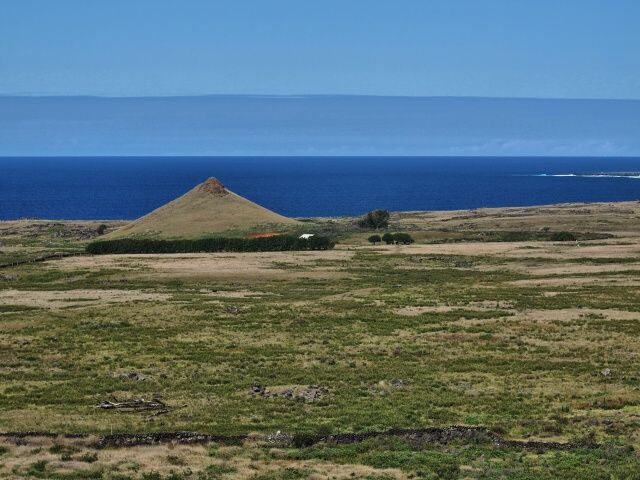
[Easter Island] Ranu Raraku – a view of a circus tent. Pardon me – of a smaller volcano near the shore
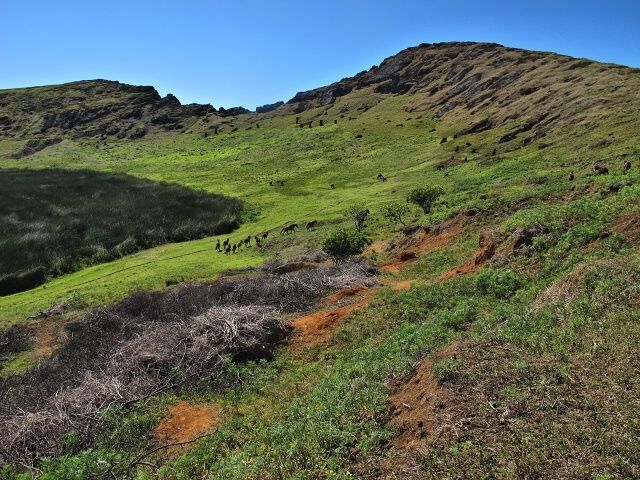
[Easter Island] Ranu Raraku – wild horses feeding in the crater
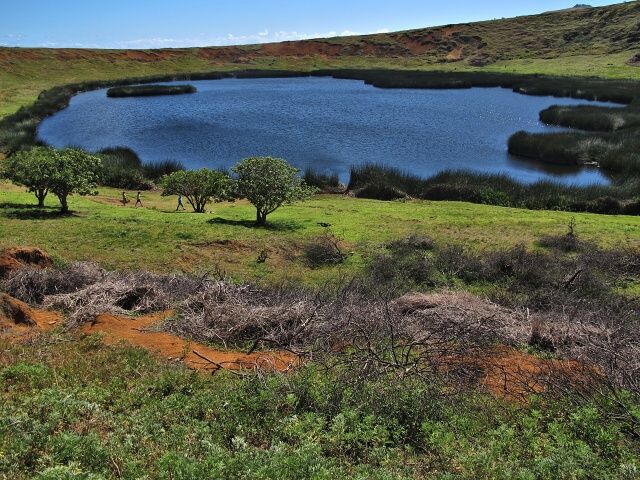
[Easter Island] Ranu Raraku – a freshwater lake in the crater
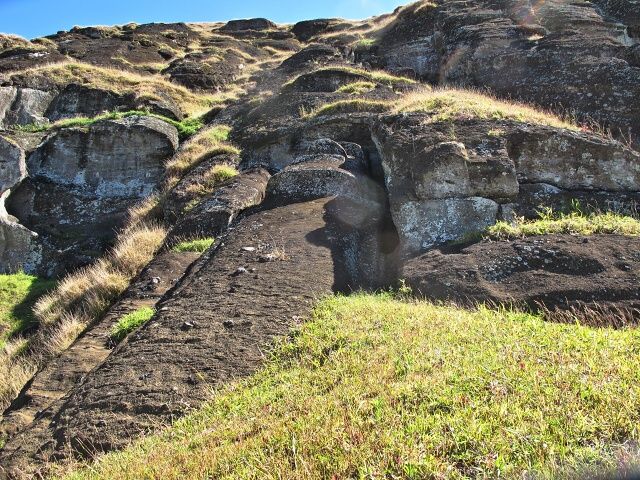
[Easter Island] Ranu Raraku – in the quarry another pretty big moai was prepared
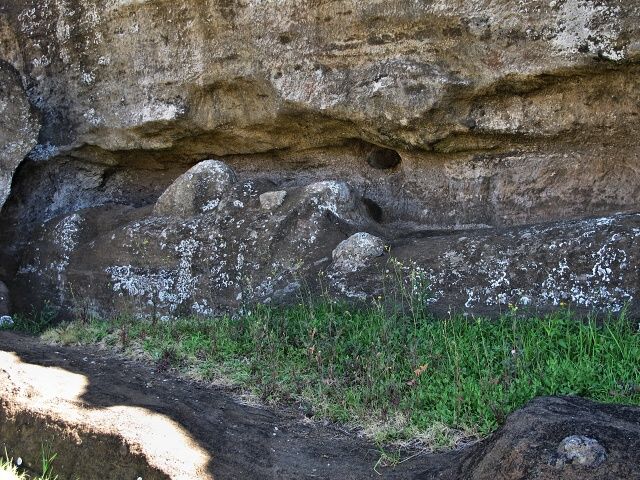
[Easter Island] Ranu Raraku - moai were created horizontally
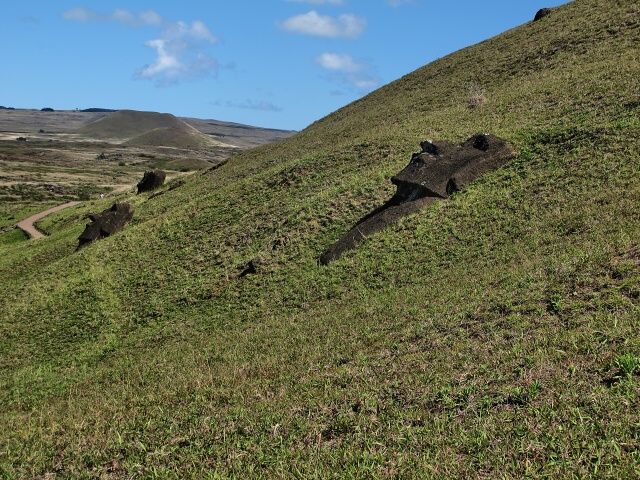
[Easter Island] Ranu Raraku – abandoned statues in various degrees of completion
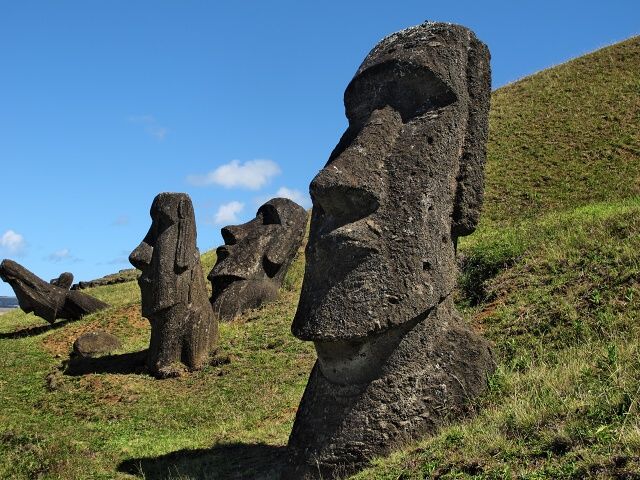
[Easter Island] Ranu Raraku - completed moai dotted on the hillside

[Easter Island] Ranu Raraku – a view of Tongariki - 'the rake' is in reality statues on a pedestal on the bay shore
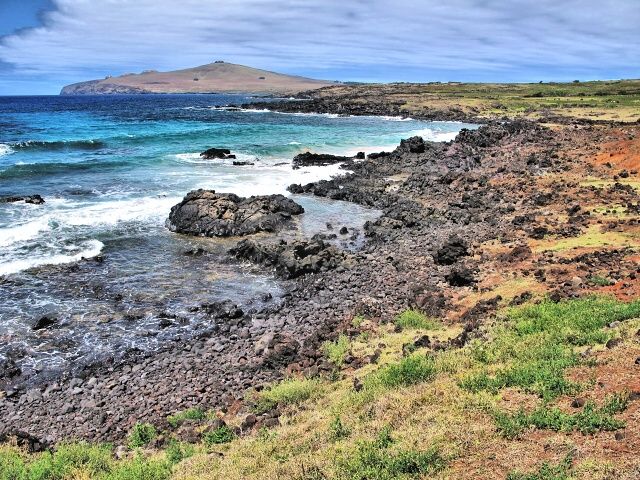
[Easter Island] Ovahe – a view of the inaccessible Poike peninsula
Wiggling Butts
This artistic virtuoso, mastered by local girls and women, was displayed with zest in the folk performance by the Kira Kira group. It was interesting when they invited female spectators on to the stage. None of them could wiggle their butts in any way worth looking at, let alone make them vibrate at very high speed to the stirring rhythm of the local music. Well, then the males, in turn, danced. This dance was used when hunting, when they shot at frightened potential enemies with bows and arrows. It reminded me a lot of the Maori performances in New Zealand, only they also stuck out their tongues. Their impression on the girls in the audience was substantial, as was eventually obvious at the Airport the next day when the boys from the group came to say goodbye to their short-term admirers.
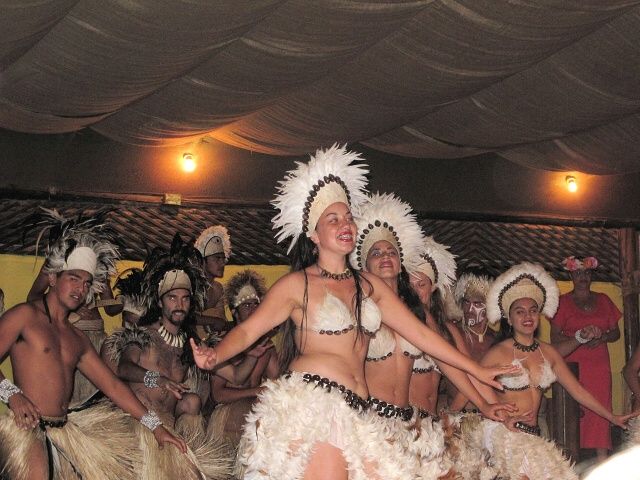
[Easter Island] Kira Kira – dance performance
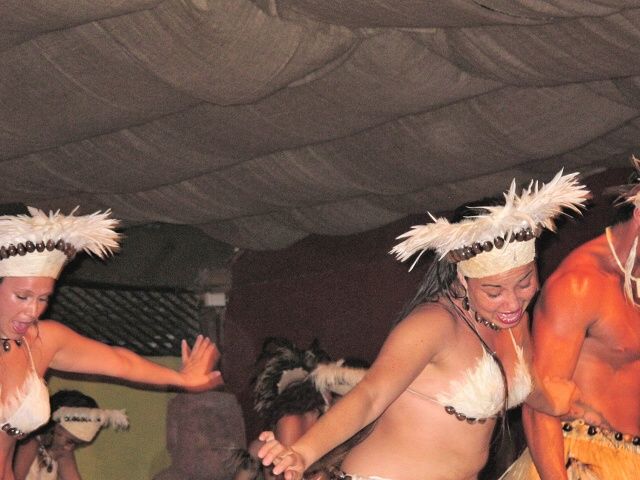
[Easter Island] Kira Kira – dance performance
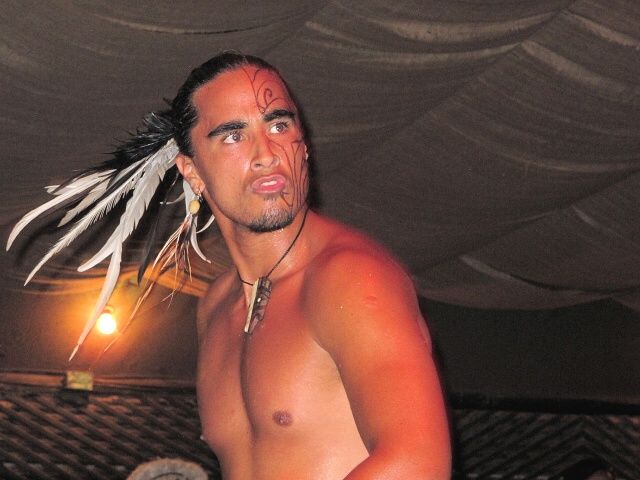
[Easter Island] Kira Kira – dance performance
Departure
In the morning, I wrapped my bike in the camp, but it did not go well. I had not accurately estimated the length of wrapping foil left on the roll, so did not have enough of it. So I took the original cut-off wrap, which fortunately was still in the trash can in the camp, glued it on to the bike and arranged it a little to at least make one side look solid. It was Sunday and the hardware store was closed, so there was no chance of buying more foil. At least I could go to Church to attend the Catholic mass sung in the local language. Yeah, it was really nice, most of the locals were singing in the choir, a beautiful atmosphere. And then they took me from the camp to the Airport. I checked in without any problems. Nobody was concerned about the overweight and the local loader promised to take care of the bike and load it into the container at the top, so that I did not have to worry about it. Half of the flight I spent standing, chatting to David, sipping red and white wine. We arrived in Santiago at 9 p.m. local time. I assembled the bike in less than an hour (pumping especially takes long, as the pump weighs only 5 dkg and its output is corresponding). I attached the bags and lights and set out for the city in the dark. I managed to get off the highways around the Airport and on to the road by which I had come. This was important, because on the way to the Airport I had realized that I had a defensive spray in the handlebar bag, so had hidden it in a deserted gumboot lying next to the road. I picked up the spray and without any problems arrived at the hostel just after midnight, checked in and went to eat in the all-night eatery in the neighborhood.
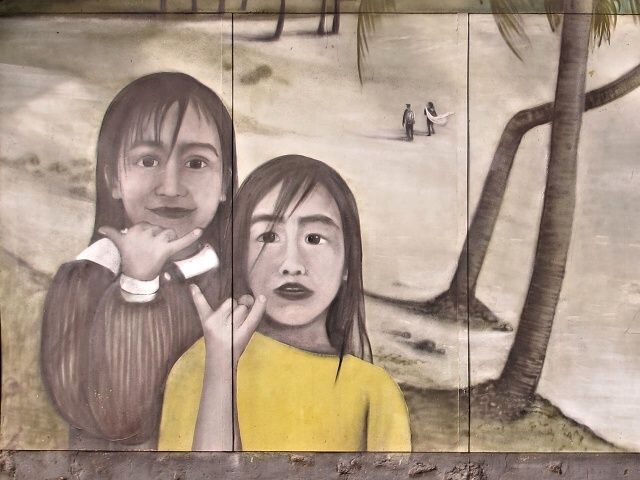
[Easter Island] Learn the greeting of the Rapa Nui people



| 














































